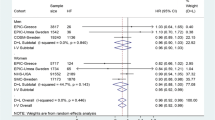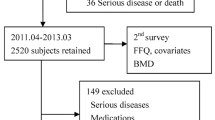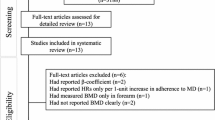Abstract
Summary
Prevention of fractures is a considerable public health challenge. In a population-based cohort of French elderly people, a diet closer to a Mediterranean type had a borderline significant deleterious effect on the risk of fractures, in part linked to a low consumption of dairy products and a high consumption of fruits.
Introduction
Higher adherence to the Mediterranean diet (MeDi) is linked to a lower risk of several chronic diseases, but its association with the risk of fractures is unclear. Our aim was to investigate the association between MeDi adherence and the risk of fractures in older persons.
Methods
The sample consisted of 1,482 individuals aged 67 years or older, from Bordeaux, France, included in the Three-City Study in 2001–2002. Occurrences of hip, vertebral and wrist fractures were self-reported every 2 years over 8 years, and 155 incident fractures were recorded. Adherence to the MeDi was evaluated at baseline by a MeDi score, on a 10-point scale based on a food frequency questionnaire and a 24-h recall. Multivariate Cox regression tests were performed to estimate the risk of fractures according to MeDi adherence.
Results
Higher MeDi adherence was associated with a non-significant increased risk of fractures at any site (hazard ratio [HR] per 1-point increase of MeDi score = 1.10, P = 0.08) in fully adjusted model. Among MeDi components, higher fruits consumption (>2 servings/day) was significantly associated with an increased risk of hip fractures (HR = 1.95, P = 0.04), while low intake of dairy products was associated with a doubled risk of wrist fractures (HR = 2.03, P = 0.007). An inverse U-shaped association between alcohol intake and risk of total fracture was observed (HR high vs. moderate = 0.61, P for trend = 0.03).
Conclusions
Greater MeDi adherence was not associated with a decreased risk of fractures in French older persons. The widely recognized beneficial effects of the MeDi do not seem to apply to bone health in these people.
Similar content being viewed by others
References
Burge R, Dawson-Hughes B, Solomon DH, Wong JB, King A, Tosteson A (2007) Incidence and economic burden of osteoporosis-related fractures in the United States, 2005–2025. J Bone Miner Res 22(3):465–475
Rachner TD, Khosla S, Hofbauer LC (2011) Osteoporosis: now and the future. Lancet 377(9773):1276–1287
Johnell O, Kanis JA (2006) An estimate of the worldwide prevalence and disability associated with osteoporotic fractures. Osteoporos Int 17(12):1726–1733
Kanis JA, Oden A, McCloskey EV, Johansson H, Wahl DA, Cooper C (2012) A systematic review of hip fracture incidence and probability of fracture worldwide. Osteoporos Int 23(9):2239–2256
Body JJ, Bergmann P, Boonen S, Boutsen Y, Bruyere O, Devogelaer JP, Goemaere S, Hollevoet N, Kaufman JM, Milisen K et al (2011) Non-pharmacological management of osteoporosis: a consensus of the Belgian Bone Club. Osteoporos Int 22(11):2769–2788
Tucker KL (2009) Osteoporosis prevention and nutrition. Curr Osteoporos Rep 7(4):111–117
Chung M, Lee J, Terasawa T, Lau J, Trikalinos TA (2011) Vitamin D with or without calcium supplementation for prevention of cancer and fractures: an updated meta-analysis for the U.S. Preventive Services Task Force. Ann Intern Med 155(12):827–838
Bischoff-Ferrari HA, Willett WC, Orav EJ, Lips P, Meunier PJ, Lyons RA, Flicker L, Wark J, Jackson RD, Cauley JA et al (2012) A pooled analysis of vitamin D dose requirements for fracture prevention. N Engl J Med 367(1):40–49
Ahmadieh H, Arabi A (2011) Vitamins and bone health: beyond calcium and vitamin D. Nutr Rev 69(10):584–598
Kant AK (2004) Dietary patterns and health outcomes. J Am Diet Assoc 104(4):615–635
Jacobs DR Jr, Gross MD, Tapsell LC (2009) Food synergy: an operational concept for understanding nutrition. Am J Clin Nutr 89(5):1543S–1548S
Sofi F, Abbate R, Gensini GF, Casini A (2010) Accruing evidence on benefits of adherence to the Mediterranean diet on health: an updated systematic review and meta-analysis. Am J Clin Nutr 92(5):1189–1196
Feart C, Samieri C, Barberger-Gateau P (2010) Mediterranean diet and cognitive function in older adults. Curr Opin Clin Nutr Metab Care 13(1):14–18
Rivas A, Romero A, Mariscal-Arcas M, Monteagudo C, Feriche B, Lorenzo ML, Olea F (2012) Mediterranean diet and bone mineral density in two age groups of women. Int J Food Sci Nutr 64:155–161
Kontogianni MD, Melistas L, Yannakoulia M, Malagaris I, Panagiotakos DB, Yiannakouris N (2009) Association between dietary patterns and indices of bone mass in a sample of Mediterranean women. Nutrition 25(2):165–171
Benetou V, Orfanos P, Pettersson-Kymmer U, Bergstrom U, Svensson O, Johansson I, Berrino F, Tumino R, Borch KB, Lund E et al (2012) Mediterranean diet and incidence of hip fractures in a European cohort. Osteoporos Int 24:1587–1598
Cummings SR, Melton LJ (2002) Epidemiology and outcomes of osteoporotic fractures. Lancet 359(9319):1761–1767
The 3C Study Group (2003) Vascular factors and risk of dementia: design of the Three-City Study and baseline characteristics of the study population. Neuroepidemiology 22:316–325
Samieri C, Ginder Coupez V, Lorrain S, Letenneur L, Alles B, Feart C, Paineau D, Barberger-Gateau P (2012) Nutrient patterns and risk of fracture in older subjects: results from the Three-City Study. Osteoporos Int 24:1295–1305
Feart C, Jutand MA, Larrieu S, Letenneur L, Delcourt C, Combe N, Barberger-Gateau P (2007) Energy, macronutrient and fatty acid intake of French elderly community dwellers and association with socio-demographic characteristics: data from the Bordeaux sample of the Three-City Study. Br J Nutr 98:1046–1057
Samieri C, Jutand MA, Feart C, Capuron L, Letenneur L, Barberger-Gateau P (2008) Dietary patterns derived by hybrid clustering method in older people: association with cognition, mood, and self-rated health. J Am Diet Assoc 108(9):1461–1471
Trichopoulou A, Costacou T, Bamia C, Trichopoulos D (2003) Adherence to a Mediterranean diet and survival in a Greek population. N Engl J Med 348(26):2599–2608
Sofi F (2009) The Mediterranean diet revisited: evidence of its effectiveness grows. Curr Opin Cardiol 24(5):442–446
Hamidi M, Tarasuk V, Corey P, Cheung AM (2011) Association between the Healthy Eating Index and bone turnover markers in US postmenopausal women aged >/=45 y. Am J Clin Nutr 94(1):199–208
Langsetmo L, Hanley DA, Prior JC, Barr SI, Anastassiades T, Towheed T, Goltzman D, Morin S, Poliquin S, Kreiger N (2011) Dietary patterns and incident low-trauma fractures in postmenopausal women and men aged >/= 50 y: a population-based cohort study. Am J Clin Nutr 93(1):192–199
Monma Y, Niu K, Iwasaki K, Tomita N, Nakaya N, Hozawa A, Kuriyama S, Takayama S, Seki T, Takeda T et al (2010) Dietary patterns associated with fall-related fracture in elderly Japanese: a population based prospective study. BMC Geriatr 10:31
Hamidi M, Boucher BA, Cheung AM, Beyene J, Shah PS (2011) Fruit and vegetable intake and bone health in women aged 45 years and over: a systematic review. Osteoporos Int 22(6):1681–1693
Benetou V, Orfanos P, Zylis D, Sieri S, Contiero P, Tumino R, Giurdanella MC, Peeters PH, Linseisen J, Nieters A et al (2011) Diet and hip fractures among elderly Europeans in the EPIC cohort. Eur J Clin Nutr 65(1):132–139
Fenton TR, Tough SC, Lyon AW, Eliasziw M, Hanley DA (2011) Causal assessment of dietary acid load and bone disease: a systematic review & meta-analysis applying Hill’s epidemiologic criteria for causality. Nutr J 10:41
McLean RR, Qiao N, Broe KE, Tucker KL, Casey V, Cupples LA, Kiel DP, Hannan MT (2011) Dietary acid load is not associated with lower bone mineral density except in older men. J Nutr 141(4):588–594
Feart C, Alles B, Merle B, Samieri C, Barberger-Gateau P (2012) Adherence to a Mediterranean diet and energy, macro-, and micronutrient intakes in older persons. J Physiol Biochem 68(4):691–700
Ott SM (2012) Review: vitamin D with calcium reduces fractures in adults. Ann Intern Med 156(12):JC6–JC7
Rabenda V, Bruyere O, Reginster JY (2011) Relationship between bone mineral density changes and risk of fractures among patients receiving calcium with or without vitamin D supplementation: a meta-regression. Osteoporos Int 22(3):893–901
Kanis JA, Johansson H, Oden A, De Laet C, Johnell O, Eisman JA, Mc Closkey E, Mellstrom D, Pols H, Reeve J et al (2005) A meta-analysis of milk intake and fracture risk: low utility for case finding. Osteoporos Int 16(7):799–804
Bischoff-Ferrari HA, Dawson-Hughes B, Baron JA, Kanis JA, Orav EJ, Staehelin HB, Kiel DP, Burckhardt P, Henschkowski J, Spiegelman D et al (2011) Milk intake and risk of hip fracture in men and women: a meta-analysis of prospective cohort studies. J Bone Miner Res 26(4):833–839
Drake MT, Murad MH, Mauck KF, Lane MA, Undavalli C, Elraiyah T, Stuart LM, Prasad C, Shahrour A, Mullan RJ et al (2012) Risk factors for low bone mass-related fractures in men: a systematic review and meta-analysis. J Clin Endocrinol Metab 97(6):1861–1870
Berg KM, Kunins HV, Jackson JL, Nahvi S, Chaudhry A, Harris KA Jr, Malik R, Arnsten JH (2008) Association between alcohol consumption and both osteoporotic fracture and bone density. Am J Med 121(5):406–418
Kanis JA, Johansson H, Johnell O, Oden A, De Laet C, Eisman JA, Pols H, Tenenhouse A (2005) Alcohol intake as a risk factor for fracture. Osteoporos Int 16(7):737–742
Farina EK, Kiel DP, Roubenoff R, Schaefer EJ, Cupples LA, Tucker KL (2011) Protective effects of fish intake and interactive effects of long-chain polyunsaturated fatty acid intakes on hip bone mineral density in older adults: the Framingham Osteoporosis Study. Am J Clin Nutr 93(5):1142–1151
Virtanen JK, Mozaffarian D, Cauley JA, Mukamal KJ, Robbins J, Siscovick DS (2010) Fish consumption, bone mineral density, and risk of hip fracture among older adults: the cardiovascular health study. J Bone Miner Res 25(9):1972–1979
Feart C, Samieri C, Rondeau V, Amieva H, Portet F, Dartigues JF, Scarmeas N, Barberger-Gateau P (2009) Adherence to a Mediterranean diet, cognitive decline, and risk of dementia. JAMA 302(6):638–648
Dargent-Molina P, Sabia S, Touvier M, Kesse E, Breart G, Clavel-Chapelon F, Boutron-Ruault MC (2008) Proteins, dietary acid load, and calcium and risk of postmenopausal fractures in the E3N French women prospective study. J Bone Miner Res 23(12):1915–1922
Jesudason D, Clifton P (2011) The interaction between dietary protein and bone health. J Bone Miner Metab 29(1):1–14
Feart C, Samieri C, Alles B, Barberger-Gateau P (2013) Potential benefits of adherence to the Mediterranean diet on cognitive health. Proc Nutr Soc 72(1):140–152
Acknowledgments
The Three-City Study is conducted under a partnership agreement between the Institut National de la Santé et de la Recherche Médicale (INSERM), the Institut de Santé Publique et Développement of the Victor Segalen Bordeaux 2 University, and Sanofi-Aventis. The Fondation pour la Recherche Médicale funded the preparation and initiation of the study. The 3C Study is also supported by the Caisse Nationale Maladie des Travailleurs Salariés, Direction Générale de la Santé, Mutuelle Générale de l’Education Nationale, Institut de la Longévité, Regional Governments of Aquitaine and Bourgogne, Fondation de France, and Ministry of Research–INSERM Programme “Cohortes et collections de données biologiques.” This specific analysis within the Three-City Study was funded by a research agreement between the INSERM and Danone Research.
Conflicts of interest
Catherine Féart received fees for conferences from Danone Research. Cécilia Samieri and Simon Lorrain report no conflict of interest. Luc Letenneur receives research support from Danone Research. Vanessa Ginder Coupez and Damien Paineau are members of Danone Research. Pascale Barberger-Gateau served on a scientific advisory board for Caisse Nationale pour la Solidarite et l’Autonomie (CNSA); has received funding for travel and speaker honoraria from Lesieur, Bausch & Lomb, Aprifel, Danone Institute, Canadian Association of Gerontology, and the Jean Mayer Human Nutrition Research Center on Aging, Tufts University; serves on the editorial boards of Disability and Rehabilitation; has received consultancy fees from Vifor Pharma; and receives research support from Lesieur, Danone, Agence Nationale de la Recherche, Conseil Régional d’Aquitaine, Institut Carnot LISA and Groupe Lipides et Nutrition.
Author information
Authors and Affiliations
Corresponding author
Rights and permissions
About this article
Cite this article
Feart, C., Lorrain, S., Ginder Coupez, V. et al. Adherence to a Mediterranean diet and risk of fractures in French older persons. Osteoporos Int 24, 3031–3041 (2013). https://doi.org/10.1007/s00198-013-2421-7
Received:
Accepted:
Published:
Issue Date:
DOI: https://doi.org/10.1007/s00198-013-2421-7




